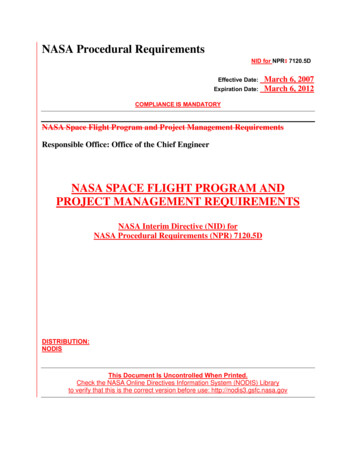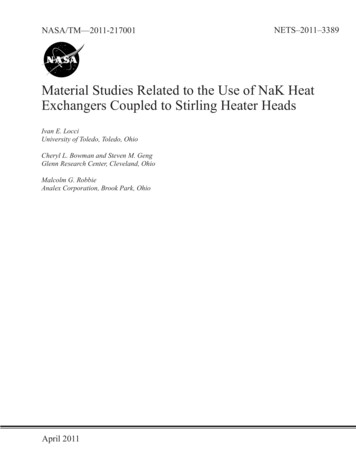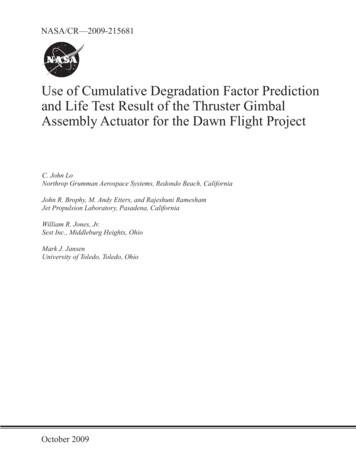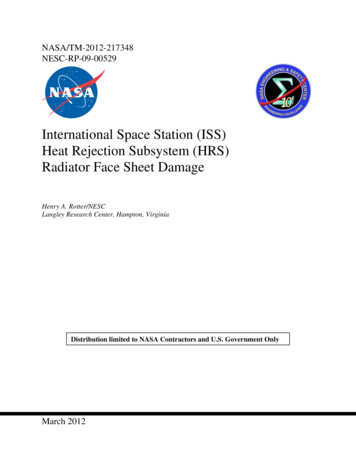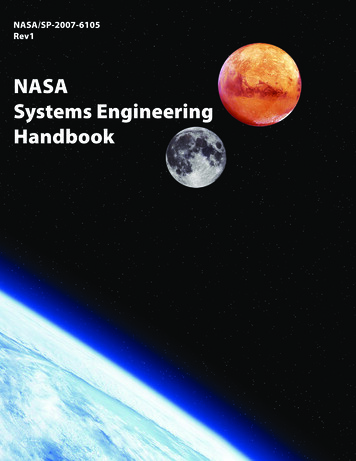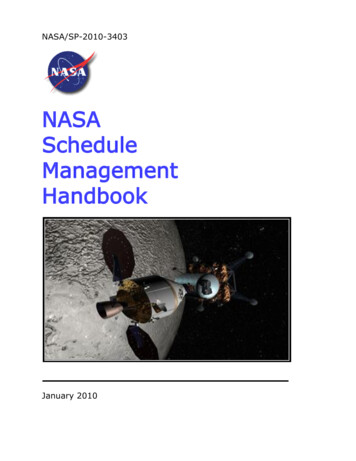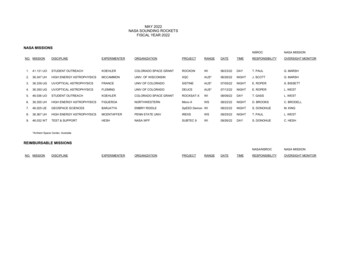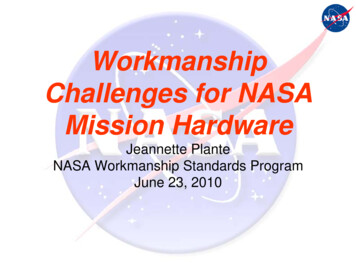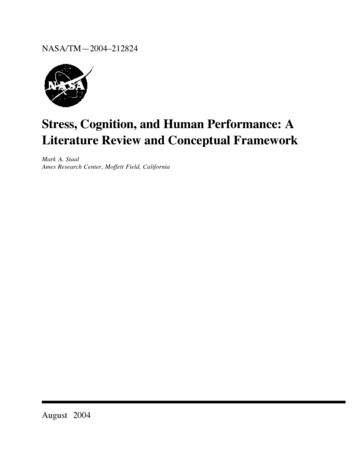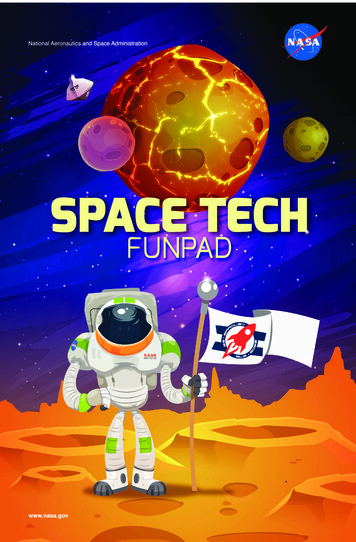
Transcription
.
.
NASA Technology in Your WorldThrough sustained investments in technology, NASA is making a difference in theworld around us. NASA technology investments in space exploration, science, andaeronautics is making it possible for us to learn more about our planet and outerspace. Many of these technologies can also be found improving your daily life.Next time you travel by car or plane or when you brush your teeth today or checkthe weather forecast, you're using a bit of NASA technology if you know it or not Technology Drives Exploration1
Computer WhizFind and circle these shapes.2
Out of PlaceCircle the robots that are different from the others.3
Solar Electric PropulsionColor the worlds.4Solar Electric Propulsion (SEP) is a project to create technology that can pushspacecraft to far-off destinations. SEP would collect the Sun’s energy throughsolar panels so that less fuel is required for the spacecraft and it can reachmuch more distant worlds.
VEGGIESAstronauts on the International Space Station used a special VegetableProduction System (VEGGIE) to grow lettuce that they could eat.Draw your own garden of food for astronauts to harvest and eat.5
Match the SatellitesDraw a line from each satellite to its twin.6
Lab TechCan you name these common tools used by scientists and engineers?7
Connect the 3456789101112The design of aircraft has changed a lot over the years. NASA has helped improveairplanes with technology that saves fuel, makes flights quicker, helps pilots trainbetter, and makes taking off and landing safer.8
Life on MarsCircle 11 things that are different in the images of an astronaut on Mars.NASA is making new tools and systems to support astronauts going toMars. Things they need include advanced life support systems to help thembreathe; an updated space suit design; technology to produce water, oxygen,and fuel on the surface of Mars; and better ways to communicate with Earth.9
Building TechnologyFind and circle these hidden shapes.10
Where Is NASA?NASA has many Centers across the United States that study Earth and spaceand build technology for exploration. Which ones are near you?Each Center has its own region for educationalprograms. Color the regions by number.1 Yellow (Ames)2 Orange (Armstrong)3 Purple (Johnson)4 Red (Goddard)5 Dark Green (Langley)6 Blue (Glenn)7 Pink (Kennedy)8 Light Blue (Marshall)9 Light Green (Stennis)11
Spacecraft SearchFind the names of these NASA FINDERCASSINIMARINERPIONEERDAWNMESSENGERSPACE SHUTTLEGEMININEW HORIZONSVIKINGJUNOORIONVOYAGER
OSIRIS-REXOSIRIS-REX is an unpiloted spacecraft that will travel to the asteroid Bennu and bringsamples of it back to Earth. It will use cameras, lasers, spectrometers, and otherinstruments for viewing different wavelengths of light, to help us learn more abouthow planets formed and how life began.13
Planetary ExplorerFill in the blanks with words of your choice to create a story.As a newly trainedtravel in thefor NASA, you get tooccupationspacecraft to visitconstellationThe mission will takenumberyears, so bringto pass the time. When you get tolive in awill help you survive thewill take samples ofcanverbadjectivenounverb, you willclothingthatenvironment. Youso scientists on Earthonsame planet!book / moviethem. The best part is that you will bethe first person to14same planetand wear a specialbuildingplanet!
Draw NASADraw a picture to represent what each letter in NASA stands for.15
Living in SpaceLiving in space will require many things we take for granted here onEarth. A place to live in, for instance, isn’t as easy to construct in spaceand would require innovative techniques to use the resources that areavailable to you. NASA is looking at innovations such as Contour Craftingtechnology that will use robots to help build habitats using lunar orMartian soil, allowing us to live off our planet and keep us protected.Photo Credit: Berok Khoshnevis, Director of USC Center forRapid Automated Construction Technologies (CRAFT)16
NASA’s Outer Space AssistantConnect the dots to see who’s helping astronauts onthe International Space Station.5756585955605461536252635165646750 496869667048714772734645444374421001014175 76 310 2963828272679 80981932 116182221 20Robonaut 2 (R2) is a humanoid robot that works aboard theInternational Space Station. It can perform tasks in microgravity anduses special climbing legs to help anchor it while it uses its hands.R2 will help astronauts make repairs to the Station.17
Hidden WordFill in the spaces with the names of everyday objects that NASA technology hasimpacted. Clues to the items are below. The letters in the bold boxmake a secret word.1.2.3.4.5.6.7.8.9.10.181. Worn to the pool or beach2. What your bed sheets cover3. A noisy machine that cleans floors4. Squeezed from a tube to freshen your breath5. Used to hit a ball back and forth across a net6. Footwear used for a sport that takes place on snowy slopes7. Tool to provide light in dark places8. Storage box for keeping food and drinks cold9. Protects your eyes from brightness10. Soft, easy-to-eat food for infants
Mystery ShadowsUnscramble the letters to name the shadow.ietselalteortckcepas itatsnocseap robpe19
Color the James WebbSpace TelescopeThe James Webb Space Telescope (JWST) is an infrared telescope thatwill look deep into space to study the earliest stars and galaxies in theuniverse. It is more sensitive than the Hubble Telescope, with much largermirror optics that have a highly reflective gold layer to gather lots of light.20
What Do You See?Draw what is outside the window of your deep-space habitat on Mars.BWP-3300.172New life support technology will allow astronauts to live and work in habitats onMars. The variable oxygen regulator keeps oxygen and pressure at a safe andcomfortable level, and the rapid cycle amine swing bed takes carbon dioxide andwater out of the air.21
Green Propellant Infusion MissionThe goal of the Green Propellant Infusion Mission is to test new types ofspacecraft fuel. The fuel that NASA currently uses, called hydrozine, is toxicand dangerous to handle. The new fuel will be much less harmful and willbe much more environmentally friendly.22
With You When You FlyHow is NASA technology improving flights at your local airport?NASA is developing a coating that will keep bugs from sticking to the surface ofplanes. This improves the planes’ speed because stuck bugs slow them down.Many of today’s air traffic control systems, which tell planes when it is safeto land and when to take off, are based on NASA-developed software.23
LCRDLaser Communications Relay DemonstrationThe Laser Communications Relay Demonstration (LCRD) is demonstrating anew way of sending information between Earth and space. Satellites will uselasers instead of radio waves to communicate, because lasers can send muchmore data than radio waves. With this new and powerful system, NASA cangather more knowledge than ever, faster, on Earth and in space.24
Learn how to say these words inSpanish, Chinese, French,and Russian.rocketcohetehuojiàn fuséeraketa ngyuán astronautkozmonautsatellitesatéliterénzào ogiagongyixuéˉtechnologietekhnologii25
Juno to JupiterLead Juno safely through the dangerousradiation belts of Jupiter!Juno is a space probe that will orbit and study Jupiter.This will tell us important information about how our solarsystem formed. Juno’s sensitive electronics must beprotected from Jupiter’s radiation by a titanium container.26
How High Can You Go?How many words can you make from the letters inTECHNOLOGY?Write your words here:1–9 words: Flying high in the atmosphere10–19 words: Low-Earth orbit20 words: The Moon and beyond!27
Orion MazeHelp Orion find Mars!Orion is a spacecraft that will carry astronauts to Mars and beyond. It will beNASA’s most advanced spacecraft in order to keep crew safe during their mission.It is designed to support long periods of space travel and to withstand the harshenvironment of reentry into atmosphere.28
How Fast?Match the spacecraft with its speed.A.17,150 mphVoyager space probeB.36,373 mph (launch)B52B launch aircraftC.38,610 mphInternational Space StationD.24,791 mph (fastest piloted spacecraft)New Horizons (Pluto space probe)E.448 mphApollo 10F.4,520 mph (fasted piloted aircraft)Juno (Jupiter space probe)U.S.AI RFO RCG.EX-15 hypersonic plane165,000 mph29
Build the NASA Ring Wing GliderProcedureDiagram 11. Fold a piece of 8.5- 11-inch paperdiagonally as shown in diagram 1.2. Make a 1/2-inch fold along the previouslyfolded edge. See diagram 2.Diagram 23. Make a second 1/2-inch fold.See diagram 3.4. Curl the ends of the paper to make aring and tuck one end into the fold of theother. See diagram 4.5. Gently grasp the “V” between the two“crown points” with your thumb andindex finger.6. Toss the glider lightly forward.Note: The folds in the paper make theairplane’s front end heavy and the backend light. Curling the ends to make aring changes the shape of the wing andimproves the wing’s flight performance.30Diagram 3Diagram 4
Spinoff Fun FactsEvery year, NASA develops new technology that helps Earth research and spaceexploration. These innovations often go on to change life on Earth, too. What aresome inventions in your life that got their start at NASA?Ski boots came from the boots in an astronaut’sspacesuit that let the wearer move around while thefeet remained attached to the surface.Today’s baby formula was created when scientistsdiscovered a healthy ingredient for babies in algaethat they were using to develop life support.Modern big rig trucks are designed with curves that help air move past thevehicle better. This is based on NASA’s research on making vehicles faster andmore aerodynamic.31
Stay up-to-date with NASA’snewest technologiesand missions.Follow us:Twitter: @NASA TechnologyFacebook: @NASATechnologyInstagram: @NASAtumblr: nasa.tumblr.comYouTube: NASA.gov.VideoSnapchat: @nasaDownload the free NASA app:Get the latest content, including news, features, images, videos, NASA TV, andtweets!Available for:Apple32AndroidApple TVKindle Fire
Answers for pages 7, 9, 18, 19 and 29page 7, Lab Techwrench safety glasses test tubemicroscope tape measure computercalculator thermometer screwdriverpage 9, Life on Mars1. satellite on left missing two solar panels2. one antenna removed from middle satellite3. different flying saucer4. three stars missing from right corner5. mars rover facing opposite direction6. spots on comet removed7. light spots and right side crater removed8. controls on astronaut’s spacesuit missingpage 18, Hidden Word1. swimsuit2. mattress3. vacuum4. toothpaste5. tennisracket6. skiboots7. flashlight8. cooler9. sunglasses10. babyfoodHidden word: TECHNOLOGYpage 19, Mystery Shadowssatelliterocketspace stationspace probepage 29, How Fast?A 38,610 mphB 448 mphC 17,150 mphD 36,373 mph (launch)E 24,791 mph (fasted piloted spacecraft)F 165,000 mphG 4,520 mph (fasted piloted aircraft)
NP-2017-02-2360-HQ34
NASA Technology in Your World . Through sustained investments in technology, NASA is making a difference in the world around us. NASA technology investments in space exploration, science, and aeronautics is making it possible for us to learn more about our planet and outer space. Many of these technologies can also be found improving your daily .

